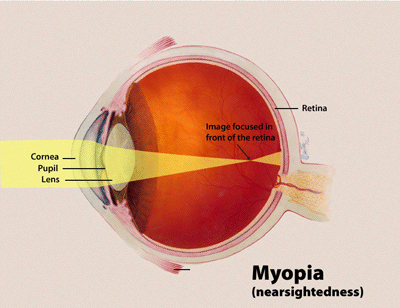
In chapter 3 Introduction to Vision was an interesting topic because of the different conditions of the eye. Since childhood, I was always told that the eye is like a camera where light passes through a lens system back onto the film. The cornea and lens located in front of the eye works like a camera lens. In the normal eye, light rays of an image pass through the cornea and then are focused directly on the retina which produces a clear image. Having the same optometrist for over 30 years with the same speech at every visit was another reason for me choosing this topic. Everything was basic and comprehensible.
My son at the age of 12 was diagnosed with myopia. In a myopic eye, the light rays pass through the cornea and lens but the point at which they converge (focus) is in front of the retina, not on the retina. Myopia also called nearsightedness is the inability to see distant objects clearly. This condition is known to have affected over seventy million Americans. This is caused by two factors 1). Refractive myopia, when the cornea or lens or even both bends the light too much 2). Axial myopia is where the eyeball is too long. In both cases it results in blurred vision (Goldstein 2010). Above is an illustration of the rays of light in front of the retina which causes blurred vision.



More intriguing information in handling this condition according to Goldstein is to move the stimulus closer to create a focused image on the retina. This will produce a far point which causes clear vision.
Non-surgical treatment options for myopia include glasses and contact lenses. Now, with the latest technology, Lasik surgery can now be performed.
Picture 1 shows how a person with see things having myopia.
Picture 2 shows how a person with corrected vision


http://www.youtube.com/watch?v=YiuC7a1lkrk
ReplyDelete